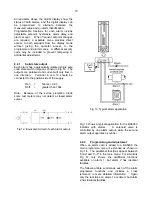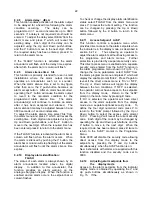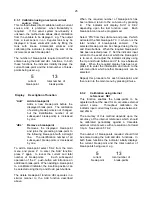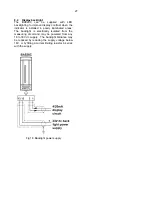
23
setpoints are not protected by a security code the
alarm setpoint prompt 'SP1' will be displayed. If
the setpoints are protected by a security code,
'COde' will be displayed first. Pressing
P
again will
allow the alarm security code to be entered digit by
digit using the
Up
and
Down
buttons to change the
flashing digit, and the
P
push-button to move to the
next digit. If the correct code is entered pressing
E
will cause alarm setpoint prompt 'SP1' to be
displayed. Pressing the
Up
or
Down
button will
toggle the display between the two alarm setpoint
prompts 'SP1' and 'SP2'.
If an incorrect security code is entered, or a button
is not pressed for ten seconds, the indicator will
automatically return to the display mode.
Fig 15
Setpoint adjustment from the display
mode
To adjust an alarm setpoint select 'SP1' or 'SP2'
and press
P
which will reveal the current setting.
Each digit of the setpoint may be adjusted using
the
Up
and
Down
push-buttons, and the
P
button to move to
the next digit. When the required setpoint has
been entered, pressing
E
will return the display to
the 'SP1' or 'SP2' prompt from which the other
setpoint may be selected, or the indicator may be
returned to the display mode by pressing
E
again.
Direct access to the alarm setpoints is only
available when the menu is enabled - see section
8.2.11
8.3
Lineariser
The indicator can be supplied with a sixteen point
lineariser which may be adjusted to compensate
for almost any non linear variable. For example, a
level signal from a horizontal cylindrical tank may
be linearised by the indicator to display the tank
contents in linear volumetric units.
The addition of linearising software does not effect
the intrinsic safety of the indicator.
Fig 16 shows a typical linearising characteristic.
Up to sixteen break-points may be programmed to
occur at any input current between 4 and 20mA.
The slope between adjacent break-points may be
set anywhere between -1250 and +1250 display
counts per milliamp.
Greater slopes may be
programmed, but the indicator performance will be
degraded. A linear characteristic can be obtained
by programming just two points, one at 4mA and
the other at 20mA.
Fig 16 Typical indicator characteristic
Inclusion of the lineariser software extends the
'CAL' and 'SEt' functions as shown in Fig 17, and
the root and null functions are omitted. from the
main menu. As with a linear indicator, calibration
may be performed with an external calibrator using
the 'CAL' function, or from the internal references
using the 'Set' function.
Summary of Contents for BA526C
Page 11: ...11 ...





































